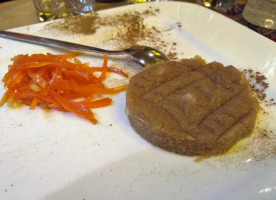Immagini
ContribuisciPrenota ora
Recensioni
Contribuisci feedbackTime running! Almost 5 years ago, as part of a Europa Park weekend – including accommodation in the lighthouse of Hotel Bell Rock – we took a trip to the pearl of Breisgau. At that time it was a lukewarm evening in August, which gave us some outdoor tapas in the venerable Casa Española. Of course, I wrote the report on this portal. At the end of January, it devoured us again for two days into the southernmost city of Germany, whose climate is animated by the people themselves in the winter months to the outside. There was no trace of contact ban and other restrictions on public life. How the situation can change in not even two months... But how did Stippvisite come over the weekend? A Christmas gift from my loved ones included two nights in an apartment, which was on foot to the old town of Freiburg. Münster, Bächle and student pubs within reach. January Tristesse adé! We were happy about the small daily life curse and of course I had made a little familiar with the culinary situation on site. However, the idea of picking up in an Afghan restaurant on the first evening came from my wife, who had information from his first colleague's hand and was recommended to Magellan as an inside tip. Good oral propaganda was also the reason for the planned visit to the “Kartoffelhaus” on the following evening. A member of our Wörther Schlemmertruppe has been sworn by this Freiburg institution for good-bourgeois tubers. I had already contacted the two return addresses, which were scheduled for Friday and Saturday evening, by telephone in advance and had reserved a table for two. From the Zollhallenstraße, where our pretty stay was located, to the Sundgauallee 110 to Betzenhausen, it was an almost one-hour walk that made us starved at the restaurant Magellan. So the best conditions for a culinary discovery tour through the aromatic Afghanistan. As soon as we had entered the locality, which is quite inconspicuous from the outside, and which is latent in the 70s, I was glad to make the reservations made in advance. This Friday evening and after a friendly reception at the Tresen, the shop was going to lead us to the back of the guest room, where a second table had actually remained unoccupied. According to the urge, it was quite lively without complicating the communication at the table. A pleasant sound level, based on merciful exchange and appetizing crockery butterfly. At the neighboring table some students had made themselves comfortable. Behind this, an older couple from Switzerland – regular guests, as the honest service manager and operator of the shop, Mr. Nazari, later advised me at the chat. Warm light flooded the reluctantly decorated, surprisingly contemporary interior of the restaurant. In the background, traditional sounds – probably from the homeland of the operators – were to be heard. Dark red carpets and small, artistically crafted embroidery placed on the walls – but rather subtle – a few oriental accents. Since July 2015, the Nazari family has taken its view of Afghan dining culture among an open-minded audience moving through all ages. It is largely dispensed with by popular deco kitsch. Tradition and modernity did not come into the way in the guest room designed with taste and sense for details, but were very well harmonized. The interested guest was presented with a collection of various spices and spice mixtures, for example Char, on the long tasting counter. In addition, there was a small septare with a Persian sitting area, a low wooden table and a lot of orientally patterned pillows and carpets. The roughly estimated room designed for a dozen people came to me with its authentic furnishing pictures, wall ornaments, lantern lamp like an independent morning microcosm. The oriental heart of the Magellan did not have much in common with the other, rather expediently designed guest room. Interior This was quite sober in terms of setup. They were placed on simple bistrotic with a bright wooden plate and non-minor functional wooden chairs, as they can be found in many dining rooms. The latter were provided with padded documents, which was definitely not a disadvantage for sitting comfort. On the longitudinal side of the guest room, high windows joined each other. Through an inlaid glass door it went outside to the completely orphaned summer terrace. May warmer times again allow the sympathetic coexistence under the open sky... Well, even inside the Magellan it was quite fun. We quickly acclimated and immediately held the food and drink electure in red cover in hands. The programme against hunger reminded me of little of the delicacies that are on the table in Indian localities. This did not surprise me, but the regional cuisine of Afghanistan was decisively determined by its geographical location on the Silk Road and thus strongly influenced by the Persian and Indian eating culture. The offer included a handful of appetizers dough bags, sheep cheese, fried vegetables in the chickpea shell, a couple of soups lentils diel and tomato cream, a scarce dozen salads and a balanced range of vegetarian dishes as well as meat dishes with clear commitment to chicken and lamb. In addition, six different grill dishes and three menus were available. The latter were found as three-course food sequences, whose starters and desserts were taken from the à la carte offer. In the main courses, however, the “policy of the mixed plate” was passed. For the first semester in the field “Afghan Cuisine” a welcome opportunity to “clean” first basics. Especially since the menus also appeared interesting 24 28 33 Euro. Also the smaller hunger was met with a few dishes. Just like the smaller guests. Oh, how would I have let my parents leave me as a child with a steamed basmati rice, of course, and felt like a minced meat sauce from the cow here. Quite apart from the sweet temptations, which in the form of Halwa Grießschnitte , Schir Berendj Afghan dairy, Firni oriental Panna Cotta and Shir Yach fruit cocktail on vanilla ice with rose water and cardamom rounded off the menu typical of the country. Well, there were also Coupe Denmark, Black Forest Mugs and Apple Strudel for less experimental slurry mowers. The beverage collection did not reveal any veritable grape juice rockets, but quite neat QbA standard. Markgräfler Gutdel and Herxheimer Honeysack Riesling from the Palatinate were quarterly at prices 4,10 and 5.10 Euro available. Fürstenberg Pils and Paulaner Hefeweizen were from the barrel. The cloudy forest house beer “without filter” from the southern Black Forest came from the 0.33l bottle for 3.30 euros. I'd like to grab the pull. For the half litre “classic” Black Forest, we were relieved by 3.80 euros. Our thirst quenchers all moved in the fairly calculated, i.e. green area. This was the colour of the pastis with ice-water 3.90 euros, which I used as an aperitif. Our first hunger should be vegetarian. We chose Pakaura 4,20 Euro and Sambosa 5,90 Euro from the list of warm little ones for pre-use. The first ones were three fried veggies, which consisted mainly of potato mass. Together with onions, zucchini and aubergine strips, the crispy pakaura were pulled once through the chickpea pastry before they were immersed in the frituse. A sharp tomato-based Chutney was added. This was very good and made for a pleasant burning on the tongue. Pakaura As Sambosa, two homemade dough bags filled with chickpeas, potatoes, tomatoes, fresh coriander and normal peas were called. Apparently a typical Afghan appetizer, which is also well suited as a remnant meal. Culinaryly located between Indian Samosas and Chinese spring rolls, these aromaticly fragrant corianders were! , frying packages a delightful start. Especially since the sharp Chutney Dip itself had a stimulating effect on the rearmost taste buds. Sambosa My wife recommended the Afghan festive court called Kabuli Palau, which could probably be translated with “Reis to Kabuler Art”. However, it opted for the vegetarian version 14,40 Euro, which was served with fried eggplants. The most afghan of all rice dishes, which were not inconsistent with a Uzbek Pilaw, was traditionally served with steamed basmati rice, carrots, almond pencils and naturally raisins. Kabuli Palau vegetarian The rice came directly from the aroma compartment of the Orient Express, because it was refined with a special spice blend of cardamom, carnations, cinnamon, coriander and pepper. To this end, a bowl with Dahl – stamped yellow lenses with roasted garlic and ginger – was also served à part. Dahl as a supplement The rice fell out fantastically loose. Along with the light sweetness of raisins and carrots, the nutty almond crunch, as well as the fragrant Garam Masala spice, which was supposedly caused by the aubergine slices covered with tomato sauce, this was an excellent veggie plate that my wife had incorporated. During this time, I was working on two juicy minced meats. Kababe Kobida called themselves the two well-formed skewers from beef chop 15.90 Euro . They also had not been saved with oriental spices. In the expertly grilled Hindukusch juices, which are actually Persian origin – they are called Kababab Koobideh in Iran – a neat amount of chopped onion and fresh parsley was hidden, which got the two protagonists on the plate very well. Kababe Kobida As a supplement, Basmati Reis also worked here, which was colored differently when considered. As I have been explained, the colour is produced when roasting in the pot and is typical of the afghan type of rice preparation, in which a little caramelized sugar is also added. The garlic sauce, which was added separately in the glass bowl, was homemade and tasted so. This was not a Convencience Mayo Plempe from the shelf, but a dip sauce with pleasant garlic freshness, which provided for a little more savory conditions on the plate. This was certainly not a fast food from the portion, but thanks to the loose rice cream and the well-sized minced meat dose no monstrous quantum as one knows from the one or the other Helenengrill. The Afghans are now truly no dimensional Bifteki beasts. In addition, the grill plate also included a wonderfully acidic side salad. What more can you want? Well, maybe something against the Diabetes Profilaxe. Of course, we wanted to invite the end of the fine meal with two oriental desserts, which is in a tasty grits called Halwa Halwa and an afghan dairy, tasted after rose water and cardamom, with the sounding name Shir Berenj both showed 4.90 euros each. Shir Berenj In my wife's dairy, Mango Püree was responsible for the fruity accent of the nightly. My not even so sweet grits were flanked by high sugared carrots Mandel Marmelade. As with the Persian variant Moraba Havij was not used here with cardamom and rose water. Such aromas are certainly somewhat unfamiliar for the European palate, as these sweets always seem somewhat perfumed. They were, however, just like the previous comrade, a consistently positive experience for us. After our dinner we climbed on the Sundgauallee into the city-wide tram. For a few beers in the Black Kater, a cozy student pub in the Old Town, there was still time. The fact that there juvenile Ü Sixties also hearted the one or other flame cakes, made the whole all the more sympathetic. Only to hope that the Magellan will survive the crisis and we will enjoy the Afghan treaties during a future visit to Freiburg. Aschak, Bolani and Mantu also want to be tried. “Mo’afagh bashed!” dear family Nazari.
Menu completo
Ulteriori informazioni
Collegamento al menu tramite codice QR








